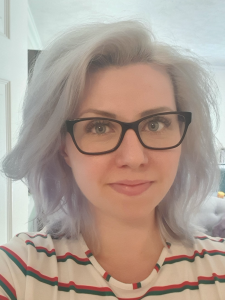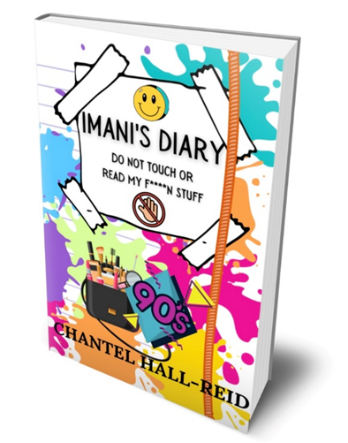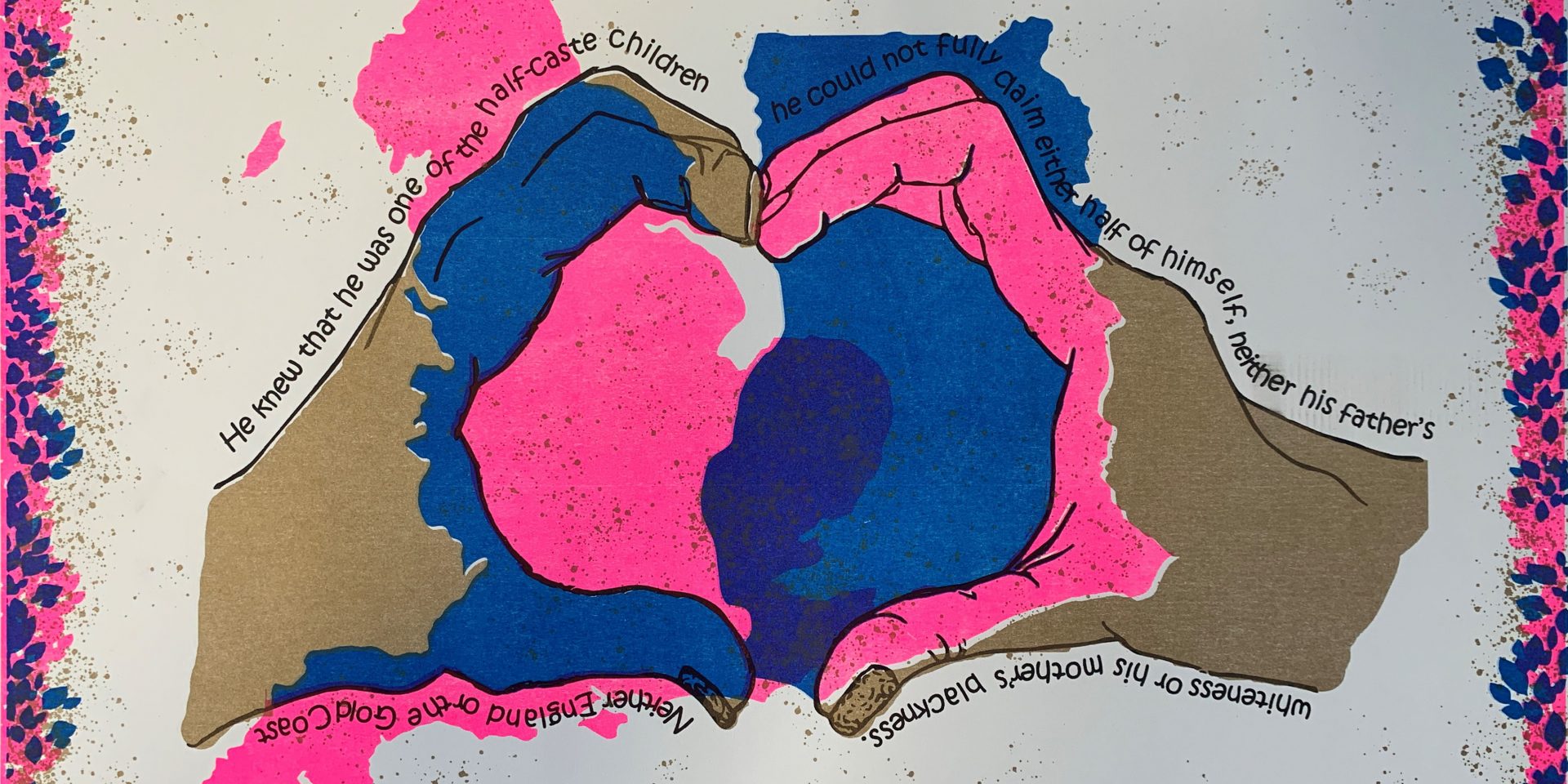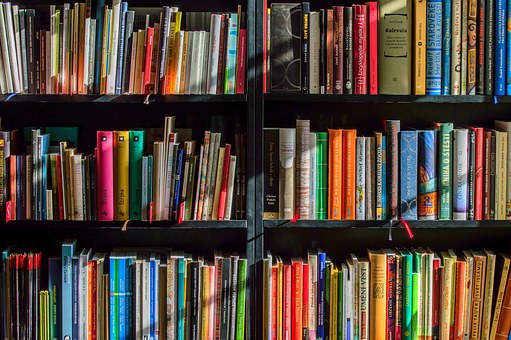Monday Moments: Black History Month, Celebrating Authors And Artists
Introduced By Holly King

This October, our Monday Moments page is dedicated to Black History Month and celebrating black authors and artists. To begin with, we have illustrative posters by Charlotte Bouchier-Webb, who tells us:
“I was so drawn in by a book I had read: Homegoing by Yaa Gyasi, I knew that I wanted to take several different quotes to illustrate, using four different characters’ experiences across the 250-year timespan.
This biographical fictional account tells the stories of two half-sisters and their descendants over the span of around 250 years. It pens the differences in the lives that they and their descendants lived, all from being born in two different parts of the same country of Ghana. One sister is married off to a wealthy English slave trader, and starts a somewhat comfortable life, while the other sister is sold off elsewhere as a slave. The stories evolve through their descendants, which describe how each lineage differed drastically, resulting in the differences in the lives of black people around the world today.”

© Charlotte Bouchier-Webb, 2021
View more of Charlotte’s work: https://cbwillustration.wixsite.com/illustration
******
Next, we are featuring Jacqueline Gabbitas. She is a poet, short story writer and editor for Brittle magazine. She is a mentor for Pen to Print’s Book Challenge and a tutor on ‘Not Afraid Of The Dark II: Ghost Story Writing For Women’ workshops, which you can sign up for here.
An Atlas Of Ghosts
The moon is full tonight. Standing on the deck of my boat, I watch a mist rise over the far-field and pour over the banks of the canal. It’s the perfect landscape for a ghost: isolated, lonely, drenched in moonlight, shrouded in mist and mystery. Perhaps a woman in white wandering the towpath in search of lost love; perhaps a figure falling endlessly from the redbrick bridge; perhaps a ravaging spirit hellbent on revenge for his murder. A quick list plucked from memory, familiar to many of us.
Ghosts make up part of every country’s folklore but how cultures approach them can be very different to one another. The ghosts I grew up with were translucent apparitions, silent and foreboding. Often, they’d met a grizzly or avoidable death. Often women. They had some message to relay — about their deaths or unfinished business — or they were after revenge or absolution. Think of Cathy in Wuthering Heights, or the many Women in White, Grey or Black. Here in the UK, we expect our dead to move on and are saddened or afraid if they don’t. We don’t generally want to meet them (except in seances) and don’t celebrate them in the quite same way other cultures do. Our Halloween might once have been a religious observance of saints, martyrs and the faithful dead, but nowadays it’s mainly just a night for cosplay and candies.
In Japan and much of Asia, for instance, the season for ghosts is summer. Obon is a three-day Buddhist festival that takes place in August. Like many festivals of the dead such as Mexico’s Día de Muertos, known for its beautifully decorated altars and skulls (Calaveras), China’s Hungry Ghost Month, in which ancestors return to earth to attack their enemies and so places are laid at the table to appease them, or Nepal’s Gai Jatra, the Festival of Cows, which includes a procession of cows, sacred to the Hindu religion, to honour those who have died in the previous year. Obon celebrates the lives of ancestors and eases their loss for those left behind, and, as in other festivals, people make offerings of food and drink to shrines; there are dances, bonfires and boat parades. The dead are not only expected to visit at Obon. Many people welcome them to see how they’re getting on in the afterlife. But Japan’s ghosts aren’t relegated to Obon. It’s a culture rich with spirits, from the kami of the natural world to the yurei and yokai of folk and urban myths. In the West, probably one of Japan’s most famous spirits is the well-ghost Sadako of the 90’s horror film The Ring, but you might not know about the child-rearing ghost who helps struggling mothers, or the 100-year-old umbrella ghost, Kasa-obake.
Ghosts of women and children are persistent themes, regardless of the culture. Among Mexico’s mountain ancestral spirits and Aztec warriors killed in battle who return as hummingbirds are the pale-faced, clawed Cihuateteo, who died in childbirth and come back to steal babies and encourage adultery, and the Wailing Woman who, rejected by her husband, drowned her children, then hanged herself and who now scours the land looking for her children. In the Caribbean, duennes are child ghosts who died before being baptised; mischievous faceless spirits, with large heads and backwards-facing feet. It’s said they roam the earth looking for a mother’s love and if parents shout their children’s names in public a duennes may well hear and then, in mimicking tones, call out to the child to lure them into the forest, where they’ll abandon them.
Back in Japan is the idea of the living spirit made of energy drawn from negative feelings about another person, but in Africa, the living spirit takes on a different, altogether positive tone. If a man dies young, his ghost is allowed to go to another town and settle down as if he’s still alive. There, he can marry without his wife even knowing he’s a ghost, until, at the end of his new life, he’ll die once more. In Iceland, among the greedy ghosts, or those with unfinished business or whose loved ones cannot move beyond their grief, is a spirit who isn’t exactly a living ghost, but a busy one: the Vokumadur — the ghost of the first person buried in a newly-established cemetery, who will protect it and its future inhabitants, and whose physical body will never decay.
The moon is full tonight and standing on the deck of my boat watching the mist rising over the far-field, I have to wonder if any of these ghosts are watching the same moon I am, and who else might be thinking of them right now.
©Jacqueline Gabbitas, 2021
*****
Now Chantel Hall-Reid, an award-winning entrepreneur, tells us about her new novel. Her mission is to support teens and women around the world in ‘finding their voice’ along with their values, so they can get in alignment with who they truly are.
Imani’s Diary is a coming-of-age novel. The entries detail the life of a teenage girl going through adolescence, attempting to navigate those crucial teen years.
The novel is set during the ’90s and, whilst for the most part, this period was considered carefree and fun, there were also deep-rooted issues amongst some of the communities in the UK that I wanted to explore.
During the ’90s, migrants to the UK were mostly Nigerians and Ghanaians. Some came initially to study; others migrated to join family and set up homes, or to take up employment in a Britain that was still hungry for skilled workers.
Many of the families who migrated came as refugees, arriving from Somalia, Zimbabwe and Sudan. But that didn’t diminish the classroom bullying and ridicule some of the teenagers were subjected to from the UK youth. Nyah, one of the characters in Imani’s Dairy, goes to great lengths to cover up the fact that she is from Africa.
Extract from Imani’s Diary:
Went to Nyah’s today. I heard her aunt on the phone. She said, “Ek dink ons het vlugte nodig.” I asked Nyah what she was saying. Nyah told me that she’s looking for flights to Africa. I said, “Africa? I thought you said your uncle lived in America?” Nyah begged me not to tell anyone her family were really from Africa. I burst out laughing. Yoooooooo! I’ve got one over on her now. If anyone finds out she’s from AFRICA, she will get dissed big-time.

Why? Well, back then, their accent was mocked, their skin tone was questioned and many UK black teenagers, in particular, didn’t want ANY association with Africa. This negativity, coupled with third world poverty portrayed on TV, was enough to want to segregate ‘ourselves’ from those coming from the Motherland.
The 2011 census revealed, between 2001 and 2011, the British African population doubled. African migrants have drawn the whole nation towards their culture. Through sports, music, fashion and (only recently) television, they have become the standard-bearers of a new cultural and national identity.
It was important for me as the author to highlight how significant the changes have been since the ’90s. Through our renewed learning and education, understanding our ‘self’ and ancestry, we have, or are at least starting, to know where we came from. They say knowledge is power.
Only through studying history can we grasp how things change. Imani’s Diary helps us examine how the past has shaped (and continues to shape) global, national and local relationships between societies and people. Through studying the lives of others, Imani’s Diary builds empathy: themes such as teen relationships, dysfunctional families, poverty, the education system, teen pregnancy and so much more are explored in her gripping diary entries.
Imani is a teenage girl growing up in an inner-city met with poverty. She faces many challenges but uses these to become better. We all have scars from our past. None of the things that have happened in the past predicts how you’ll end up in the future. You can use your past as a source of confidence, knowing that you won’t make those same mistakes.
Becoming the person you dream of takes a lot of self-reflection and diving into the past, to figure out who you wish to be in the future.
So today, I support teens to reframe their history, find their voice and live a life that’s fully aligned with their values, so that they, too, can reach their full potential.
© Chantel Hall-Reid, 2021
Connect with Chantel at her website www.chantelhallreid.com, on Facebook www.facebook.com/ChantelHReid and on Instagram www.instagram.com/chantelhallreid
*****
And we finish our Monday Moments October page with a feature from Ruth D-Whyte, an Educational Consultant with over 25 years of experience. She is also one of the co-founders of So He Cares Educational and Childcare CIC.
One of my interests lies in raising awareness about SEND rights and helping my audience create a more courageous lifestyle.
I will be part of a Pen to Print event in October 2021. My session will be on the practicalities of the Educational Health Care Plan. This workshop will be centred around one of my books: My Excellent Child. I have observed with dismay learners who have been excluded from school settings, rejected and labelled, and not given any opportunity in a school setting. In addition, my interactions with parents have shown they have little or no knowledge of the same plan set out to define their children’s lives.
As of 2019, the Department of Education reported 354,000 children and young people with the Education, Health and Care (EHC) plan maintained by local authorities. There has been an increase of 34,200 (11%) as of January 2018.
Behind this group of children and young people lies a group of parents seeking answers to the many diverse situations they face. In the words of Michael King, Financial Ombudsmen 2019:
“…. Always on the receiving end of these problems are children missing out on the support to which they are entitled, and families left to pick up the pieces. In addition, we often see parents fighting the system established to support them, with inevitable delays, frustration and distress. As a result, it is not uncommon to hear the SEND process described as a battleground.”
Throughout history, negative perspectives have been discovered towards children and individuals with disabilities and impairments. They were considered and portrayed to have less worth and excluded from many parts of society. The recent discoveries in the documentary from BBC showcased the 1960s and 70s with black children who were labelled as “educationally subnormal” and wrongly sent to schools. These pupils were deemed to have low intelligence, and while I watched the programme, I asked myself several questions: What differences do we have regarding this today, or have our children with special needs been treated better? With 1.32 million UK pupils in 2019 known to have a disability, the scale of the problem is rising. How can we shape our future and help those children with special needs?
We can learn from our past and begin now to make a difference by imbibing the right strategies regarding inclusion and much more. It’s about time we all begin to structure our future together. There is a dire need to advocate for these many-faceted challenges, which will serve as a driver for our own professional growth and development.
© Ruth D-Whyte, 2021
Connect with Ruth on Facebook: www.facebook.com/RuthDeeWhyte/
*****
Don’t forget you can check out issue 10 of Write On! magazine here. Submit your short stories, extracts, poems, art, music, film and all things creative to us at pentoprint@lbbd.gov.uk
Our Monday Moments page is dedicated to Black History Month and celebrating black authors and artists.




